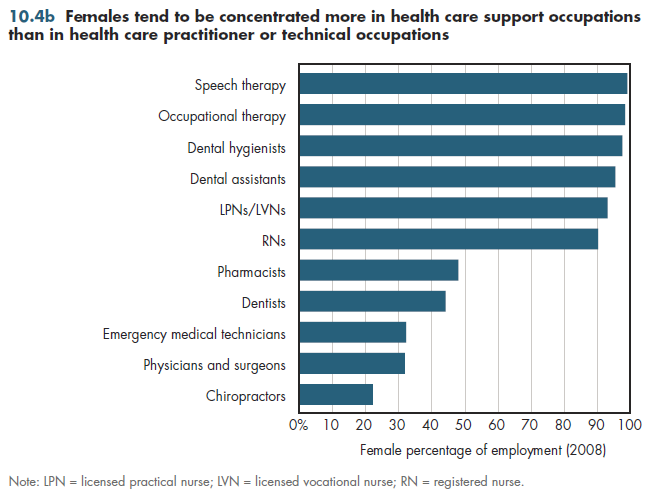Download PowerPoint versions of both figures.
10.4 Share of Female Employees in Health Sector
Summary: Females account for more than 75 percent of health sector employees but constitute fewer than half of employees in the goods-producing part of the health sector.
Note: You are viewing an old version of this document. The latest version is available here.
Although females make up fewer than half of all civilian workers, they comprise more than 75 percent of workers in the health sector (figure 10.4a). This share varies dramatically across different components of the health industry. In the goods-producing part of the industry—manufacturing of pharmaceuticals, medical equipment, and supplies (which together make up only 6.5 percent of health sector employment)— the female share is slightly less than among all civilian workers.

In the services part of health care, the share of female workers is dramatically higher. In home health care, nine of 10 workers are women. In nursing-care facilities, seven of eight workers are female (although in residential facilities that do not provide skilled nursing care, the female share is less than 75 percent). Most ambulatory health services have a workforce in which women make up 75 percent of employees. Hospital workers have approximately the same share of female workers.
The differences in share of females are even wider at the individual occupational level. Women make up 88 percent of health care support occupations such as nursing and home health aides, compared with fewer than 75 percent of workers in health care practitioner and technical occupations. In the five health-related occupations that have the highest share of females, women make up more than 90 percent of employees (figure 10.4b). Also shown are registered nurses (RNs), who make up the single largest occupation in health care, almost 90 percent of whom are female.

The five occupations in which women are least represented include four that require doctoral training; these include chiropractors (22 percent), physicians and surgeons (32 percent), dentists (44 percent), and pharmacists (48 percent). Although some pharmacists have only bachelor's degrees, all newly minted pharmacists now must have a doctorate. However, these numbers are gradually changing. Currently, females comprise half of all medical students; chiropractics is also seeing an increase in the female share of graduates.
Downloads
References
- Author's calculations.
- Department of Labor. Bureau of Labor Statistics.
Content actions
Give feedback:
Add module to:
Reuse / Edit:
Twin Cities Campus:
- © 2012 Regents of the University of Minnesota. All rights reserved.
- The University of Minnesota is an equal opportunity educator and employer. Privacy
- Last modified on Oct 18, 2013 2:19 pm -0500







